Double duty
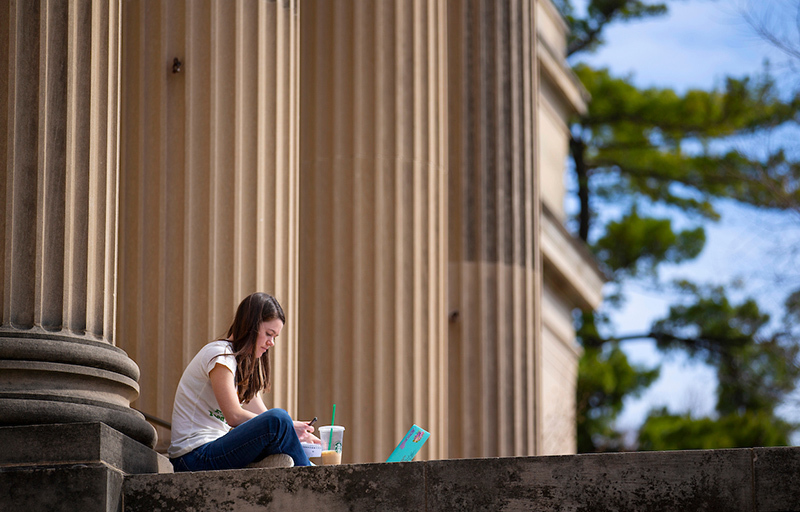
Photo by Christopher Gannon.
Sophomore animal science major Grace German soaks up some sun Monday afternoon while studying on the front steps of Curtiss Hall. Just two weeks remain in the semester before final exam week is here.
Pronouns can be added to university-branded items
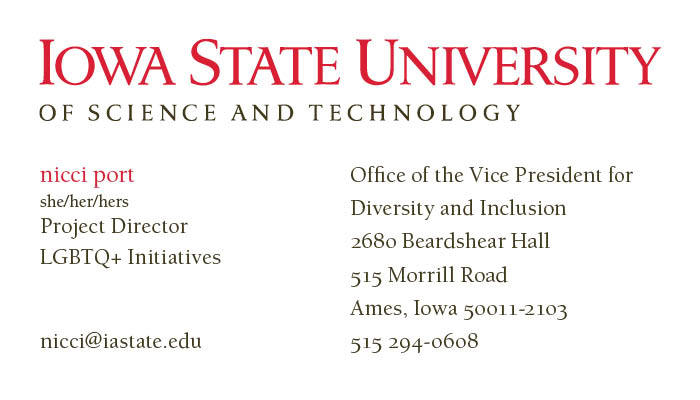
Business card
Seeing three words "she/her/hers" officially added to Nicci Port's business card marked the completion of something she began in 2004.
Starting April 1, employees could add pronouns to university-branded items such as business cards, nametags, desk nameplates and email signatures. Misidentifying someone using a pronoun that does not correctly reflect the gender they identify with was a driving force for this change.
Working with the office of university marketing, procedures were set up to help interested employees add pronouns to these identification items:
- Business cards: Using an online form, pronouns can be included below the person's name in a smaller font.
- Permanent nametags: The official format includes the university wordmark at the top, with the unit name below. The person's name goes across the bottom, with pronouns located below. Orders are made by phone to Cyclone Awards and Engraving, the licensed vendor for the university.
- Desk nameplates: There is an area for a person's name, with their pronouns underneath. Phone orders are placed to Cyclone Awards and Engraving.
- Email signatures: Pronouns have been available for email signatures for some time. Employees can add them in a field within Outlook. An email signature generator also is provided on the website and can be used to copy the information to an account. The pronouns display below the name and title.
The right time
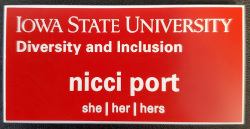
Nametag
Port, project director for LGBTQ+ initiatives in the office of diversity and inclusion, said referring to an individual by the proper pronouns is like getting a name correct.
"I encourage people to think about how if someone misnames me that can be upsetting, and pronouns are the same thing," she said. "As the leader of the LGBTQA+ faculty staff association in 2004, we would ask if we could add pronouns, but it was not part of the template. There wasn't a lot of movement until recently."
Port said several things came together to allow adding pronouns to university items. Continuing requests by employees, the creation of the office of diversity and inclusion three years ago, and relationship building between diversity and inclusion and university marketing offices all helped. An article last fall in the Iowa State Daily also brought more attention.
"We are always looking for accommodations, and there have been more requests for pronouns on university items, so we felt it was time to take the step to ensure everyone at the university feels respected," said Carole Custer, director of university marketing. "I think this is a step forward and helps everyone feel like they are valued."
Port said she received positive feedback from faculty and staff who added pronouns to university items. She also sees it as an important step for the university.
"I think it positions Iowa State as a more welcoming campus, which is one of President (Wendy) Wintersteen's main goals," Port said. "If you exchange business cards and someone sees that Iowa State understands the importance of pronouns, that might do us well in recruiting students and employees."
Thiel elected to American Academy of Arts and Sciences
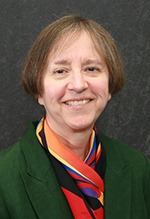
Pat Thiel
Patricia Thiel, who studies surface chemistry on an atomic scale, has been elected to the American Academy of Arts and Sciences.
Thiel is one of more than 200 newly elected members announced April 17 by the academy. She will join the academy’s chemistry section within its mathematical and physical sciences class. Formal induction ceremonies will be in October in Cambridge, Massachusetts.
Thiel is a Distinguished Professor in Liberal Arts and Sciences with appointments in chemistry and materials science and engineering. She’s also a scientist at the U.S. Department of Energy’s Ames Laboratory.
"This is an amazing honor for me, but just as much for the many gifted and generous people who have worked with me over the years, especially my graduate students and postdocs, and the theoreticians with whom we’ve collaborated," Thiel said. "I am very, very happy that our achievements have been recognized in this way."
Iowa State and Ames Laboratory leaders praised Thiel’s research and leadership:
- “Dr. Thiel’s election to the American Academy of Arts and Sciences is an extraordinary endorsement of her research and scholarly excellence,” said President Wendy Wintersteen. “We are very proud of her achievement and we deeply appreciate her leadership in the pursuit of excellence at Iowa State University.”
- “We are absolutely delighted to hear of Pat’s election to the Academy,” said Adam Schwartz, Ames Lab director. “Her research has been invaluable to advancing our understanding of quasicrystals and metamaterials. She has served the laboratory well in multiple leadership roles, and is a strong and constant collaborator with scientists around the globe. This is recognition well-deserved.”
The late Earl Heady, an agricultural economist at Iowa State, is Iowa State’s only other member of the academy, according to the academy’s directory. He was elected to the academy in 1977 and Heady Hall on campus was named after him in 1982.
The academy was founded in 1780 with the idea of honoring accomplished people and engaging them in the public good. Members include Benjamin Franklin, Albert Einstein, Margaret Mead and Martin Luther King Jr.
This year’s class is the academy’s 239th.
“With the election of these members,” said academy president David Oxtoby, “the academy upholds the ideals of research and scholarship, creativity and imagination, intellectual exchange and civil discourse, and the relentless pursuit of knowledge in all its forms.”
Wallace Road will close temporarily at Gerdin Building
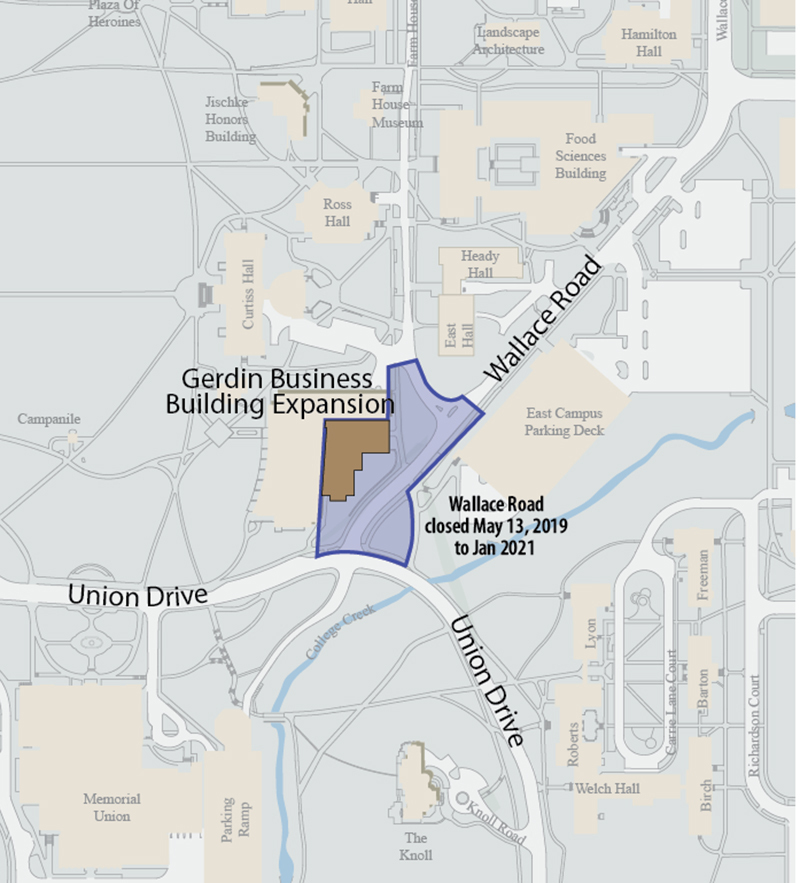
Purple shaded area indicates the construction fence boundary while a four-story addition goes up on the east side of the Gerdin Building. Map courtesy of facilities planning and management.
Excavation began last month for a $28 million, four-story addition to the Gerdin Business Building, a large track crane was delivered to site this week and the construction pace will pick up when spring semester ends. To create space for construction staging on a tight corner, a section of Wallace Road -- from the Union Drive intersection to the north entrance of the east campus parking deck -- will close Monday, May 13, for an estimated 20 months. The closing places the road and most of the lawn west of the parking deck inside construction fence until January 2021.
Senior construction manager Rob Ebel, facilities planning and management, said the south end of Farm House Lane also will close, as will sidewalks adjacent to the two closed road segments.
The sidewalk emerging from the northwest corner of the parking deck, which angles south to Union Drive, will remain in use, and crews are installing a temporary sidewalk this month south of East Hall to create a safe pedestrian corridor between the open section of Farm House Lane and Wallace Road.
Despite all the activity around it, Ebel noted the building will remain accessible. Three of Gerdin's four entrances -- the northeast, southeast and west doors -- will remain open during construction, as will the loading dock on the northeast side of the building and the parking lot (49) north of it.
Temporary traffic signal
During the Wallace Road closing, a temporary three-way traffic signal will replace the all-way stop signs at the Wallace/Beach roads intersection (by the Forker Building). With the Forker lots and the east deck accessible from just one direction, the traffic light is intended to help move the additional vehicles through that intersection more efficiently, said FPM landscape architect Rhonda Martin. The signals will be equipped with walk request buttons for pedestrians.
"The impacts of the Gerdin Building expansion don't stop at the construction fence and were part of the planning from the beginning of the project," Martin said. "We hope we identified the issues and planned ahead to minimize inconveniences for employees and students."
Impact to summer bus routes
Two CyRide bus routes normally would use that stretch of Wallace Road during the summer. The orange circulator, which connects central campus to the veterinary medicine campus via the Iowa State Center, instead will exit central campus on Union Drive and Lincoln Way. The blue route, which connects central campus to South Duff Avenue via South Fourth Street, also is impacted by summer road projects on the west side of campus. The blue route's campus loop will be pushed out to Sheldon Avenue on the west and Beach Road on the east.
Martin noted FPM crews enlarged two bus stop pads just north of the Wallace-Beach intersection to accommodate anticipated larger numbers of riders seeking to board or exit a bus. One stop is south of General Services Building, the other is east of Agronomy Hall.
Construction traffic only
Ebel said all construction-related traffic to the Gerdin site will arrive from the north on Wallace Road and exit to the south on Union Drive.
Senior seeks to discover why college was so expensive
In the last month of his last semester at Iowa State, Honors senior Brandon Beecham is squeezing in a research tour of sorts. He's a presenter during three undergraduate research events: April 1 at the State Capitol with other regent university students, April 17 at ISU's undergraduate research symposium and May 1 during the spring Honors poster presentation event (3-5 p.m., Memorial Union Great Hall).
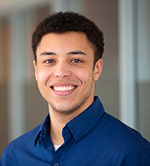
Brandon Beecham
The accounting and finance double major, who will start in John Deere Financial's early career development program this summer, attributes his research topic to his fascination with financial statements and his student debt.
"I love reading financial statements," he confessed. "I was looking at Iowa State's financial statements, which are online, and I got to thinking, what about all of this is causing tuition prices to rise?"
So, Beecham collected, charted and analyzed all university accounts from 1990 to 2018, in five-year intervals, to track changes and identify trends. (Actually, he did this for all three regent universities but agreed to talk about just Iowa State with Inside.)
His goal?
"I wanted to see which accounts changed the most over 28 years, how they interact with each other and how they impact tuition prices," he said. "It's a topic so many people know about first hand but maybe don't understand why."
The trends he identified didn't surprise him, he said, though the gravity of a few of them did. A few examples:
1. Adjusting for inflation (Consumer Price Index), state appropriations to Iowa State went from about $348 million in 1990 to $234 million in 2018. "That's a huge decrease -- over $100 million -- in real dollars. That's incredible," he said.
If state funding is supposed to help subsidize tuition for Iowa residents, Beecham said it's not doing the job it once did: $18,506 per Iowa student in 1990, $12,322 per Iowa student in 2018.
2. Iowa State has responded to the drop in state support with more university aid in the form of grants and scholarships, 70% of which address financial need, Beecham said. Available data didn't allow him to trend financial aid all the way back to 1990, but he noted nearly a tripling of university aid since 2005.
"Because scholarship dollars have gone up so drastically, my interpretation is that we're doing a good job making sure college is not getting more expensive for those most economically vulnerable," he said. He noted that the average loan debt has decreased for Iowa State undergraduates over the last 10 years after a decade or more of steadily increasing.
3. Beecham links the drop in state funding to two other trends: large increases to nonresident tuition and a drop in instructor pay relative to Iowa State's peer group. Twenty years ago, he noted, Iowa State faculty pay was at or slightly above the average of peer faculty at 11 land grant universities; today, it's around .91 on a 1.0 index.
"We can't keep cutting instructor pay or our faculty will leave, our national rankings will go down and we'll lose international students who use those rankings," he said.
The group most affected by the reduction in state support is out-of-state students, who have seen much higher tuition increases than resident students.
"We're increasing their rates so fast to keep our resident tuition rates down," Beecham said. "Students from middle-class families don't get the need-based scholarships and don't have the disposable income to pay for college."
He's concerned that neither trend is sustainable. Illinois is working on legislation to lower its resident tuition to keep Illinois students in the state; others could follow suit, he said. Without that higher tuition to subsidize resident tuition rates, "we're going to need some other source of funding," he concluded. "These trends aren't sustainable."
Photo by Christopher Gannon.
Students become teachers in Rising Star program
While Iowa State Extension and Outreach has a significant role in the university fulfilling its land-grant mission, many students aren't aware of what extension employees do.
One of the goals of the Rising Star Internship Program is to expose students to extension so they better understand what kinds of jobs are available, said region 1 extension director Cheryl Heronemus. Student interns get hands-on experience with guidance from extension staff.
"If you look at the demographics of the staff that work for extension, there are a lot that will be aging out in the coming years, and we are concerned about growing our own replacements," Heronemus said. "We want to get Iowa State students involved in an extension career so they at least know it is an option. Most of them think about 4-H and don't realize all we do."
The intern program began in 2014 under the direction of Heronemus and Bob Dodds, assistant vice president for extension and outreach county services. The first year saw interns, who work in groups of three from mid-May through early August, placed in two of extension's 20 regions. This summer, interns will work in four regions. Participating regions typically rotate each year.
Most of the interns' work centers around food, including development of donation gardens, nutrition education, and teaching adults and children how to grow and prepare food. Economic development also has been a recent focus.
Continuing to grow
Almost 30 students applied for paid internships this year open to undergraduate students who will be entering at least their sophomore year next fall. Extension provides housing, which helps build teamwork among the interns who live and work together, Heronemus said.
Rising Star draws interns from four colleges -- Design, Human Sciences, Liberal Arts and Sciences, and Agriculture and Life Sciences -- with funding coming from the colleges, host regions and the office of the vice president for extension and outreach.
"Having four colleges involved in this program makes it unique," Dodds said. "You have students from different colleges looking at a problem and each of them deciding how they can best address a need."
The work done by the interns benefits each region, but the effort behind each project is key.
"We don't want it to be an assistantship where they just come and help with things at a fair or camps," Heronemus said. "We want them to be in charge of things, have the ability to plan things from the beginning and carry it out so they can evaluate it at the end."
Staying in Iowa
John Lawrence, vice president for extension and outreach, shared statistics with the state Board of Regents on Iowa State graduates, noting 62 percent of Iowa resident undergraduates stay in state after getting their degrees, compared to 22 percent of nonresidents. Rising Star hopes to build on both numbers.
Through 2018, there have been 46 Rising Star interns. Four subsequently accepted positions in a county extension district, while another serves as an extension county council member. Dodds said two of last year's interns were offered jobs by a business in their region.
"The two students were not from Iowa. They came to Iowa State, and it gives us a chance to take some diversity out to our rural areas with students that bring different experiences," he said.
Heronemus sees the impact the program makes.
"All of the interns give a presentation to the deans from their colleges at the end of the summer, and one of the things we hear them say most is, 'As a result of what I did this summer, I am interested in a career in extension,'" she said.
Outdoor concert will close parts of north lots April 24-25
The Student Union Board's annual outdoor concert will be held Thursday, April 25, in Lot 29 north of the Molecular Biology Building. Gates open at 5 p.m. for the 6 p.m. concert featuring R&B artists Ella Mai and Bazzi.
In preparation, a section of Lot 29 will close Tuesday evening so crews can erect the concert stage. Additional sections of lots 29 and 28 will close at 8 p.m. Wednesday, April 24. All lots should reopen at 6 a.m. Friday, April 26.
On concert day, vehicles will not be allowed to enter the north campus lots (27-30, 33, 35) after 4:30 p.m. Winlock and Morrill roads will be barricaded, so vehicles in the lots will exit via WOI Road (west side) or the drive north of the Advanced Teaching and Research Building (east side). ISU police officers will assist with traffic at the end of the work day.
The concert will be held regardless of the weather. Tickets for the public are $39 plus fees and available online from Midwestix or at the Maintenance Shop box office in the Memorial Union (11 a.m.-5 p.m. weekdays). ISU student tickets are $25 in advance, $30 on April 25.
ISU Theatre explores questions of identity, community through 'Iowa Odyssey'
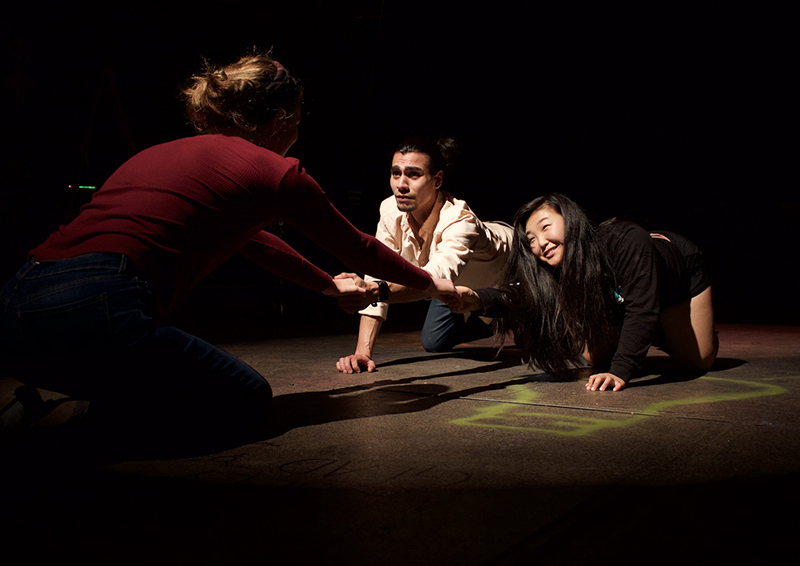
From left, Lena Menefee-Cook (junior in performing arts), Rob Delgado (senior in performing arts) and Jillian Kurovski (senior in animal ecology) rehearse for ISU Theatre's production of "Iowa Odyssey." Photo by Zoey Lazere.
ISU Theatre's "Iowa Odyssey (or How We Got to Here)," a unique, locally sourced collaboration about identity, community and hope, opens Friday, April 26, at Fisher Theater.
The impetus for the original show came from conversations with ISU's diversity and inclusion staff about the challenges undocumented students face in sharing their personal stories, said Amanda Petefish-Schrag, assistant professor of theatre.
"[The office] is hearing these compelling stories, but the act of sharing puts students at risk," Petefish-Schrag said. "We began exploring how to use theater's technique and privilege to tell stories that would allow conversations to take place in the light of day instead of behind closed doors."
Using a pastiche of narratives and new and old storytelling techniques, "Iowa Odyssey" shares real-life stories that resulted from months of local research. Last fall, the production's student advance team began interviewing Ames community members and ISU students, faculty and staff about their experiences of culture, identity and immigration. The team also conducted archival research on the history of immigration in Iowa.
"This show isn't about London or New York or other places, but here," Petefish-Schrag said. "It is a story of us. All the stories relate to 'how did we get to here,' both geographically and philosophically. How did we arrive at this moment, and who are we when we say we are Iowans? We're exploring how the questions of identity and where we come from shape how we can build a community together."
The stories in "Iowa Odyssey" expand beyond those of undocumented students. One story focuses on the Babel Proclamation of 1918, issued by Iowa Gov. William Harding during the anti-German sentiment of World War I. The proclamation stated that only English could be spoken in schools, public places, telephone conversations, meetings and religious services.
Push and pull
A set of stories titled "Pushing and Pulling" highlights immigration through circumstances that "push" people to Iowa -- such as a humanitarian crisis -- and opportunities that "pull" people to Iowa for work or education. In "Stories that Root Us," performers will share family stories gathered from interviews and explore how stories passed down through generations create belonging and identity.
Advance team member Bethmari Marquez Barreto, a junior animal ecology and performing arts major from Guaynabo, Puerto Rico, said she felt a responsibility to use her identities as an artist and multicultural student to bring attention to an important social issue.
"I have always wanted to share my experience, compare it to others and see the differences and similarities within our journey," she said. "What better way to express all of our stories than through theater, which is a great and creative platform to address things that we might not want to talk about?"
Rob Delgado, a senior in performing arts and advance team member, said the opportunity to develop a show based on unique stories attracted him to the project.
"In 'Iowa Odyssey,' we have a chance to tell stories of individuals that nobody else may ever get to hear," he said. "What does it take to shape a person? What is identity? What is diversity? How do people perceive these traits and qualities of the people? By telling the stories of others, we learn about individuals, but more than that, we create community."
After completing their initial research, the advance team recruited students to join story-building teams. Each team was assigned a story to develop for stage, then write, design and perform for the final show. The highly collaborative experiment created both excitement and risk.
"We are anticipating that we won't know what the show looks and sounds like until about one week before it opens," Petefish-Schrag said. "We also are leaving the door open so that if there is a change in the national conversation about immigration that we can act as artistic first-responders and incorporate that conversation into the show."
Petefish-Schrag said "Iowa Odyssey" does not pose public policy suggestions but creates spaces for stories.
"We want to invite people into a conversation," she said. "Our role is not to say what they have to make of that conversation."
Taking the show on the road
"Iowa Odyssey" is intended to have a life beyond Ames. ISU Theatre is planning a performance in Perry and envisions helping other communities create their own versions of locally sourced theater. This means the set and costumes for the show are equally unique.
"Everything has to fit in the back of a Ford Taurus," Petefish-Schrag joked. "This show is not locked into a specific performance place."
"Iowa Odyssey (or How We Got to Here)" evening performances are April 26 and 27 and May 3 and 4 at 7:30 p.m. Matinee performances are April 28 at 1 p.m. and May 5 at 2 p.m. All performances are in Fisher Theater.
Tickets ($18 for adults, $16 for seniors and $11 for students) are available through the Stephens Auditorium ticket office, Ticketmaster or the Fisher Theater box office prior to performances.
